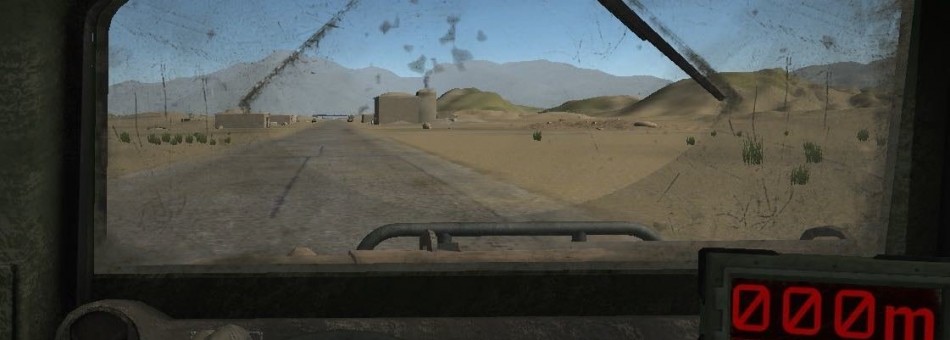Healing Minds with Virtual Reality
Published April 2, 2015 on Nova Next
It’s the smell that most easily takes Tommy Furlong back to 2010, back to when he was a Marine Corps infantry officer living in a mud hut in Afghanistan—burning garbage, diesel fuel, residue from recently fired weapons. One whiff of the distinct cocktail and Furlong is mentally transported to a different time, a different place, all while sitting safely in an office in downtown Boston. Smell is just the beginning. Slipping on a virtual reality headset, Furlong can open his eyes and find himself in the passenger’s seat of a Humvee with a digitized driver and gunner standing beside him, steadily rolling past Afghan hills while a distant radio jabbers in the background. A pad beneath his feet rumbles to simulate the jostling of the vehicle. He also holds a fake gun, the approximate size and weight of the type he carried during his service.
“It brings back that muscle memory,” Furlong says. “You get right back into that mode. You put on the headphones and start hearing that radio chatter and it just comes right back to you.”
Furlong, who served abroad in 2010 and is now the director of outreach and peer support for the Red Sox Foundation and Massachusetts General Hospital Home Base Program, says that this virtual reality world looks, smells, and sounds very similar to where he lived in Afghanistan. Today, part of his work involves to demonstrate the program to those who want to learn more about it and to discuss how easily this virtual experience brings up rich memories of his service abroad. Reliving a piece of that service history is exactly what therapists here at the Home Base Program want. A clinical care and support services organization for service members, veterans, and their families, Home Base is one of a handful of facilities across the country that uses virtual reality as a tool for treating post-traumatic stress disorder.
Designed to recreate some of the combat conditions under which trauma began, the Virtual Iraq and Virtual Afghanistan modules that Home Base uses were created to augment traditional talk therapy says Peg Harvey, a psychologist and director of the Intensive Program for Home Base. “It seems that folks are able to get more details out more quickly” with virtual reality, Harvey says. It can take more sessions with talk therapy alone.
Currently, many combat veterans are treated with prolonged exposure therapy, which requires them to recount their traumas with guidance from a therapist. Typically, prolonged exposure therapy starts off slowly with patients describing the scene, then gradually builds as patients add in more details about the trauma. Reliving their trauma in a safe, clinical setting can help patients process their emotions and “develop a less fear-inducing, more balanced response to the memory,” Harvey says.
But prolonged exposure therapy works best when patients can emotionally and cognitively connect with the memory, which is sometimes a tough challenge. Virtual reality exposure therapy supplements memories by providing visual, auditory, tactile, and olfactory cues that can be customized to a patient’s experiences. As combat vets talk through their trauma while immersed in Virtual Iraq or Virtual Afghanistan, therapists can add in pixelated people, scenery or improvised explosions to make the experience match the patient’s memories as closely as possible. Those extra cues can sometimes help patients who have either plateaued or don’t respond to traditional therapies.
“Generally, [virtual reality] can be used as a tool to help folks that are either having difficulty remembering events or difficulty emotionally engaging in the memory,” Harvey says, adding that about eight patients have used VR exposure therapy since Home Base added it a year and a half ago. “I feel like treatment goes a little more quickly [with virtual reality], and that’s what the research has shown.”
Post-traumatic stress disorder isn’t the only mental health condition that’s getting a boost from virtual environments. As the cost of VR comes down, researchers are increasingly looking to the technology to help study and treat everything from phobias to addictions to autism. It’s also being used as a tool to help those on the other side understand what it’s like to live inside a brain that processes information differently. For example, Viscira, a company that creates interactive technologies for the life sciences industries, recently produced a virtual reality experience designed to simulate schizophrenia, complete with voices echoing inside the user’s head.
New Avenues
The brain reacts almost identically in VR as it does in real life scenarios says Skip Rizzo, creator of Virtual Iraq and Virtual Afghanistan and director for medical virtual reality at the University of Southern California’s Institute for Creative Technologies. “If you model something in VR—and you do a halfway decent job with it—and somebody’s interacting in that space, pretty much similar areas of the brain light up,” Rizzo explains. “You can fool the brain. It doesn’t have to be an exact replica of reality for people to suspend belief and interact with the digital content as if it’s the real thing.”
Because the brain is so eager to believe the sensory input it’s receiving, therapists don’t always need to show blood and gore in order to get patients sufficiently immersed enough to exhibit PTSD symptoms. Rizzo has recently built and is currently testing a VR scenario for survivors of sexual trauma, but those who use it will never actually see a simulated attack. “We’re building the places but only in so far as they lead up to a point where you feel that loss of control or you’re feeling trapped,” he says, which should elicit enough response for treatment. “It’s more Hitchcock than Hurt Locker.”
Virtual reality also allows scientists to create research contexts they may not be able to otherwise, for either practical or ethical reasons. Patrice Renaud, principal researcher at Institut Philippe-Pinel de Montréal, a maximum security psychiatric facility in Canada, has studied sex offenders since 1994. Up until relatively recently, it was difficult to observe sex offenders as they were being aroused and thus figure out what triggers those urges. Since arousal often requires having images or videos of real people, showing those materials can be ethically problematic, especially if children are involved. Virtual avatars can’t be harmed in the same way that real people can, making them the perfect tool for studying arousal. Since using virtual reality, Renaud’s research has uncovered motor and eye movement patterns in sex offenders that are different from those of ordinary people during arousal. He says that examining what’s happening in offenders physiologically, psychologically, and neurologically at the moment they’re triggered could help researchers understand more about offender recidivism and could lead to more effective treatments in the future.
The Limits
Virtual reality therapies aren’t a panacea though. They simply don’t work for some patients for reasons that are unclear, though it’s also worth noting that they do work for a certain subset of patients who don’t respond to traditional therapy. Researchers also don’t know how long the effects of these therapies last. Though scientists have used virtual reality to do everything from improving speech patterns to reducing racial biases, there aren’t many longitudinal studies to show how well those changes fare in the real world.
Cost is a major obstacle as well, though not for long. A full VR set up that includes sight, sound, smell and touch cues currently costs around $30,000, reports Michael Jacobson, CEO of Virtually Better, Inc., the company that sells Virtual Iraq, Virtual Afghanistan, and produces about 50 other VR modules which address problems ranging from alcoholism to astraphobia, fear of storms. But the prohibitive costs of VR may radically change soon. With lower-cost technologies like the Oculus Rift gaming headset and Samsung’s Gear VR headset, which transforms specially-adapted smartphone apps into VR experiences, Jacobsen says that he believes his company will be able to deliver smartphone virtual reality apps that only have visual and audio cues for under $500 next month.
Still, cheaper technology alone won’t completely eliminate the cost barriers of virtual reality. Building a specially tailored virtual world is costly, especially if it’s for a study or treatment that requires participants to be fully immersed. Patrick Bordnick, associate dean of research and director of the University of Houston’s Virtual Reality Clinical Research Lab, recently spent $40,000 on two custom-designed virtual heroin dens, no hardware included. He’ll use both for a National Institute on Drug Abuse-funded study on extinguishing cravings in drug users.
Because the study is contingent on triggering actual cravings in drug users, Bordnick needed the world to feel real and to include as many accurate environmental and psychological details as possible. That meant doing serious field research on how addicts interact in triggering environments—Bornick’s virtual heroin house is accurate right down to the way addict avatars lean back in their chairs to “coast” after snorting or injecting—and investing in a highly detailed visual environment that can trick the mind into believing it’s real. In Bordnick’s previous research on using VR to reduce cravings from smokers and alcoholics, developers spent months creating virtual cigarette smoke that wafts just like the real thing and digital drinks that reflect light in the same way that actual drinks do.
“In virtual reality, we have to build all that but if you didn’t have those [cues] there, your mind would sense something is off,” Bordnick says. “If you did that with enough things in the environment, it’s going to seem fake.”
Lowering the cost of virtual technology may not change how much it costs to create a highly realistic VR world, but it will impact how VR therapy is done. JoAnn Difede, director of the Program in Anxiety and Traumatic Stress Studies at Weill Cornell Medical College, has developed VR software and treatment for patients who showed signs of PTSD as a result of the 2001 World Trade Center terrorists attacks. Currently her team is working on portable VR software that patients can use at home on a smartphone or computer to practice the coping skills they’ve learned in therapy sessions.
“We’re not going to give people the entire virtual world. We don’t want them to be overwhelmed,” she says. Rather, they will be given limited experiences. Homework, for example, might include walking through peaceful, virtual scenarios of things that people with PTSD could find difficult, like going to the grocery store. “That would make an even gentler transition into confronting what you’re afraid of in the real world,” she says.
We won’t really understand how virtual reality-augmented therapies stack up to the treatments mental health professionals have traditionally used until there’s more data that measures results over the long term. Several studies have shown that VR therapy reduces symptoms of PTSD as far as six months after patients stop treatment, but there isn’t any research on how well patients fare several years later. Patrick Bordnick and Skip Rizzo both say that they’re encouraged by the few studies that do follow up with patients months after their VR exposure treatment has ended. “You see the results holding up,” Rizzo says.






